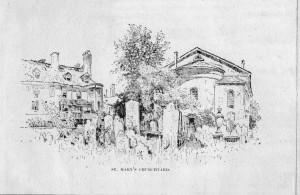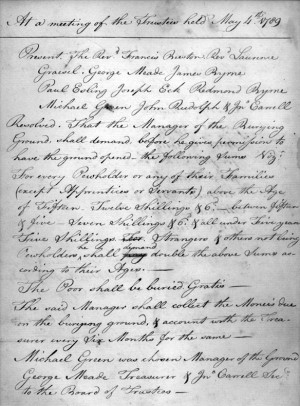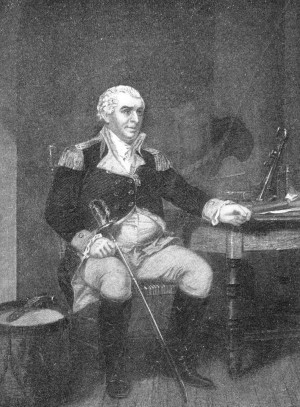Commodore John Barry, father of the American Navy. George Meade, grandfather of Civil War hero General George Meade. Katrina, Philadelphia servant. Katrina?
What does a servant girl have in common with these decorated war heroes and well-known patriots? They share a final resting place in Old St. Mary’s Cemetery where the famous and the ordinary lie side by side.
The cemetery lies in the heart of Philadelphia’s historic district at 4th and Spruce Streets. The earliest tombstone inscription bears the date 1760. Before the establishment of the cemetery, Catholics were buried in a tiny plot adjoining Old St. Joseph Church (est. 1733) as well as in the Catholic section of the public burial ground at Washington Square.
In the latter part of the 18th century, the German congregation of Holy Trinity acquired a strip of land from St. Mary’s to be used specifically for burials of their members. The two parishes continued to share the burial ground for the next century.
Early meetings of St. Mary's Board of Trustees, which are documented in the parish's Minute Books, discuss resolutions concerning the burial ground, including who had permission to be buried there and the costs required. A meeting of the Board on May 4, 1789 states, "For every Pewholder or any of their Families (except Apprentices or Servants) above the age of Fifteen-Twelve Shillings & 6d-between fifteen and five-Seven Shillings & 6d. & all under Five years Five Shillings. 'For' Strangers and others not being Pewholders he shall demand double the above sums according to their Ages. The Poor shall be buried Gratis-..."
Perhaps the most famous grave in Old St. Mary’s is that of Commodore John Barry. A native of County Wexford, Ireland, Barry served with distinction during the War for Independence, and was the first Commander- in- Chief of the United States Navy.
Bishop Egan, the first Bishop of Philadelphia, was initially interred in Old St. Mary’s. In 1869, his remains were removed to the vault beneath the Cathedral Basilica of SS. Peter and Paul.
During the American Revolution, a French general who fought at the Battle of Brandywine drowned in the Schuylkill River. General Philippe C. Ducoudray was crossing the river on the Market Street Ferry when his horse leaped over the side, with the general on its back. The general was buried at Old St. Mary’s, although the exact location of his grave is not known. One of the last acts of the Continental Congress before the British occupation of Philadelphia was to attend General Ducourday’s burial.
Hundreds of ordinary Catholics lie in unmarked graves alongside these famous burials. One that bears mention is Katrina, a poor servant whose last name was never recorded.
According to Catholic historian and journalist Martin I.J. Griffin, Katrina moved to Philadelphia from Lancaster to receive the ministry of the Jesuit Father Ferdinand Farmer. She worked as a servant of an innkeeper in Philadelphia. Katrina survived the yellow fever epidemic that ravaged the city in 1793.
Fear of the fever was so great that survivors sought protection even from the dead. For sanitary reasons, over 2,600 loads of earth were spread over the surface of Old St. Mary’s Cemetery, raising the burial ground. Katrina, in order to secure a free burial, offered to spread one hundred loads of earth by hand. She died several years later after sustaining crippling injuries in a fire. True to her wishes, Katrina was buried in Old St. Mary’s Cemetery beneath the soil she helped spread. Her unmarked resting place remains unknown.
Time and weather have taken their toll on this cemetery, rendering many tombstones unreadable. In 1891, the American Catholic Historical Society published a list of the inscriptions of those tombstones that were still legible to document the deteriorating written record.
Fitting memorials mark many of the graves in the cemetery. Other graves contain the remains of the not-so-famous faithful, who labored to build the Church in Philadelphia.
More information about Old St. Mary and its cemetery(ies) can be found in the Records and Researches of the American Catholic Historical Society. Along with other materials relating to Old St. Mary, PAHRC has the parish's Minute Books from 1788-1899.





